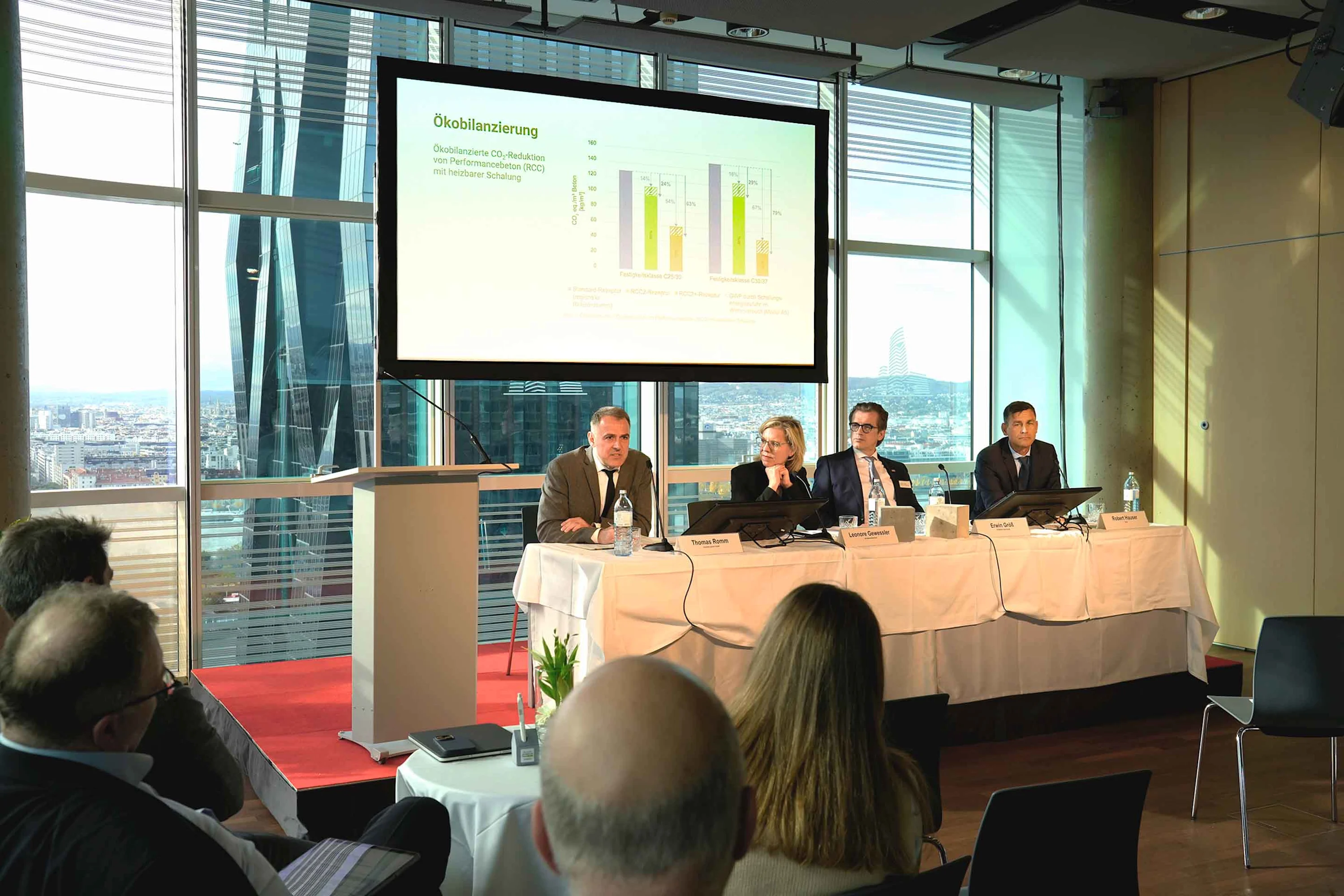Press Release:RCC2 research project

by Marco Seltenreich

f.l.t.r. Thomas Romm (forschen planen bauen), Leonore Gewessler (Federal Minister for Climate Action), Erwin Größ (Managing Director STRABAG Real Estate Austria)
©DokaThe Austrian research study RCC2 (reduced carbon concrete) investigated the potential of innovative concrete mix designs to decarbonise concrete. The broad-based consortium tested ways of establishing CO2-reduced and even climate-neutral concrete as the new state of the art.
In the RCC2 research project, a unique consortium consisting of STRABAG Real Estate, Doka, Romm ZT, Mischek ZT, bauXund, CarStorCon Technologies, MPA Hartl and the concrete manufacturers Asamer, Holcim and Wopfinger worked closely together. Their common goal is to overcome the technical, legal and economic hurdles of establishing CO2-reduced concrete as the new state of the art and to open the way for this climate-friendly building material on Austria's construction sites.
In the previous RCC (reduced carbon concrete) project back in 2021, the consortium investigated the practical use of clinker-reduced concrete mixes on construction sites. Compared to standard concrete, these RCC concretes have a significantly smaller carbon footprint, but still have one disadvantage: they take longer to harden, especially at low outside temperatures. In practice, this leads to longer construction times and higher costs, as striking the formwork, for example, may be delayed and the formwork material is therefore in use on the construction site for longer.
Focus on life cycle assessment
The current study therefore focuses on building a functional prototype of an intelligently heated formwork developed by Doka. This should compensate for the delayed strength development of RCC concretes at low ambient temperatures. Electric heating of the formwork also consumes energy, the production of which in turn emits CO2 – something the project participants are aware of. This apparent conflict can be neutralised using electricity from renewable energy and the smart use of heating for the component. Assessing the life cycle of heatable moulds for clinker-reduced concrete is therefore an important key in evaluating the sustainability and sensible use of innovative RCC formulations.
In this cooperation project, research was also conducted into how these innovative concrete formulations can be developed to be even more climate-friendly by adding technical carbon based on biochar.

f.l.t.r. Thomas Romm (forschen planen bauen), Leonore Gewessler (Federal Minister for Climate Action), Erwin Größ (Managing Director STRABAG Real Estate Austria)
©DokaFocus on life cycle assessment
The current study therefore focuses on building a functional prototype of an intelligently heated formwork developed by Doka. This should compensate for the delayed strength development of RCC concretes at low ambient temperatures. Electric heating of the formwork also consumes energy, the production of which in turn emits CO2 – something the project participants are aware of. This apparent conflict can be neutralised using electricity from renewable energy and the smart use of heating for the component. Assessing the life cycle of heatable moulds for clinker-reduced concrete is therefore an important key in evaluating the sustainability and sensible use of innovative RCC formulations. In this cooperation project, research was also conducted into how these innovative concrete formulations can be developed to be even more climate-friendly by adding technical carbon based on biochar.
Extensive series of tests
The project team carried out extensive test series that simulated both summer and winter conditions. Each test series comprised floor and wall elements with 3 different mix designs: a standard concrete (as a reference), a CO2-reduced concrete mix design (RCC2) and a CO2-reduced concrete mix design with technical carbon (RCC2+). All components were monitored in the laboratory in accordance with the relevant standards, and their temperature development was documented using Doka’s Concremote concrete monitoring system. This enabled the project partners to draw conclusions about the strength development of the individual mixtures at any time.
An important contribution to the establishment of CO2-reduced concrete
The starting point for the winter tests the consortium carried out are the reference values from the summer series: Here, all the concrete mix designs tested achieved the required strength for stripping the formwork after 24 hours. Due to the delayed strength development of RCC concretes, one component per mix design with – and one component without – heated formwork was constructed in the winter test.
The tests clearly show that in the winter tests with low ambient temperatures, heated formwork proved to be crucial in order to support the strength development of the RCC mixes and also to avoid the damage to the concrete components that would have occurred due to the temperature conditions below zero degree Celsius.
Furthermore, now it is evident that clinker-reduced concrete, especially when technical carbon is added, has the potential to significantly improve the carbon footprint of concrete. For example, with the RCC2+ concrete mix (with technical carbon), the CO2 savings potential compared to the reference concrete is around 80% for ceilings (without heating). At winter temperatures with the support of a heated formwork, the potential CO2 reduction of RCC2+ is still 67%.
The tests with the functional prototype of an intelligently heated formwork from Doka create an important perspective for an industry-wide use of CO2-reduced and climate-neutral concrete regardless of temperature, construction site conditions and, depending on construction progress, also while maintaining the usual demoulding times.
SOLEY - Pilot project with RCC concrete in residential construction
STRABAG Real Estate is building a pioneering energy and climate showcase with the SOLEY residential project in Vienna's Brigittenau district. CO2-reduced performance concrete is being used for the first time in this new residential building in Leystrasse. In addition, the building is supplied with electricity via a photovoltaic system including battery storage and – thanks to a groundwater heat pump – is independent of fossil fuels for heating.

SOLEY
Vienna · Under construction
Type
- Living
- 1200 Vienna
Cooperation within the industry
Due to its unique structural and physical properties, there will be no way around concrete as a building material in the future. It is equally undisputed that radically reducing the CO2 footprint of concrete is one of the most urgent environmental priorities in the construction sector. Researchers, politicians, and the industry are therefore working on various solutions, such as the reduction of clinker, CO2 cycle processes, and carbon capture programs.
The RCC2 research project emphasises the vital importance of collaboration in the construction industry. The results prove that bringing together different experts creates opportunities for innovation in decarbonising this most important building material without compromising on performance.
Statements:
Leonore Gewessler, Federal Minister for Climate Action, Environment, Energy, Mobility, Innovation, and Technology: “The transformation of our construction industry plays a significant role in achieving climate neutrality by 2040. A significant amount of CO2 can be saved through renovation and resource-efficient construction. In many areas we already found solutions, while further research and innovation is required in others. I am pleased that research in CO2-reduced concrete is progressing rapidly and producing good results. It is one of the many tools we will need on the road to climate neutrality.” Harald Fritsch, Board Member of Asamer Baustoffe AG and Managing Director of Transportbeton: “Building with concrete brings the opportunity to create climate-friendly buildings that can be heated and cooled with renewable energy throughout their lifetime, while using component activation to provide an excellent indoor climate. By participating in this research project, we aim to unlock the potential to reduce the carbon footprint of the production phase of our building material.”
Thomas Belazzi, Managing Director of bauXund: “The use of low carbon concrete is a particularly effective way of reducing the carbon footprint of concrete structures. This is why we participate in the RCC2 research project – because bauXund has been advising on sustainable construction for 20 years.”
Thorsten Groeneveld, Managing Director of CarStorCon Technologies: “We see this research project as a great opportunity to make the construction industry as a whole more climate friendly. We are looking forward to making concrete an environmentally friendly and future-proof building material with our Clim@Add additive made from technical carbon.” Robert Hauser, CEO of Doka GmbH: “The RCC2 research project is an important milestone in the exploration of climate-friendly construction with concrete. However, if we are to use CO2-reduced concretes efficiently and safely on construction sites, we also need to address the formwork. That is why we are focusing on innovation at the formwork-concrete interface: our commitment is to drive the decarbonisation of the construction site in line with our Net-Zero 2040 goal.” Christof Kunesch, Managing Director of Holcim Beton Österreich: “On our way to Net Zero, Holcim is relying on innovation partnerships along the entire value chain with our CO2-reduced cement and concrete. The key to practical application is always a comprehensive and holistic assessment of resource and energy use, as well as ensuring the best possible processing quality.” Erwin Gröss, Managing Director of STRABAG Real Estate Austria: “As a developer, we recognize our responsibility to create energy and resource-efficient projects for the future. The research and subsequent use of RCC concretes is an important step in reducing the carbon footprint of the construction industry.” Franz Denk, Technical Managing Director of Wopfinger Transportbeton: “We have been actively practicing sustainable recycling for years with our eco-concrete product line that is reducing the carbon footprint of our concretes. The RCC2 project is an opportunity to test, specify and apply the next generation of sustainable concretes with architects, construction and formwork companies.” Thomas Romm, forschen planen bauen ZT: "Proving the equivalent performance of CO2-reduced concrete is about nothing less than the decarbonisation of building with concrete. Heatable formwork to support early strength makes CO2-reduced concrete practicable and brings significant environmental benefits."
About the project:
Project title: Life cycle assessment of heated formwork for CO2-reduced concrete Abbreviated title: RCC2 Duration: 2022-2024 Funding authority: Federal Ministry for Climate Action, Environment, Energy, Mobility, Innovation and Technology & City of Vienna MA20 Project lead: forschen planen bauen DI Thomas Romm ZT Project and research partners (in alphabetical order):
STRABAG Real Estate GmbH
Inquiries & contact:
forschen planen bauen ZT Thomas Matthias Romm Architect +43 650 984 84 88 thomas.romm@romm.at
Doka GmbH Alexandra Weidinger Head of External Communication +43 664 62 94 111 alexandra.weidinger@doka.com
STRABAG Real Estate GmbH Martina Magnet PR & Kommunikation +43 676 53 92 404 martina.magnet@strabag.com
Contact

